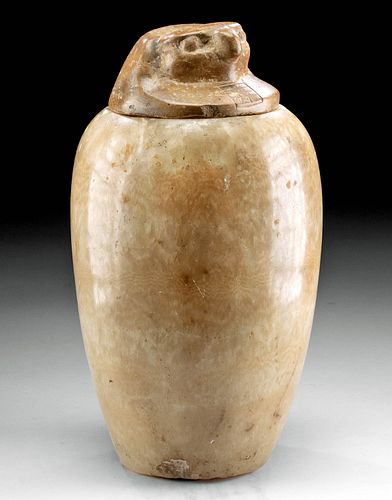Egyptian Alabaster Canopic Jar w/ Qebehsenuef Lid
Lot 11
About Seller
Artemis Fine Arts
686 S Taylor Ave, Ste 106
Louisville, CO 80027
United States
Selling antiquities, ancient and ethnographic art online since 1993, Artemis Gallery specializes in Classical Antiquities (Egyptian, Greek, Roman, Near Eastern), Asian, Pre-Columbian, African / Tribal / Oceanographic art. Our extensive inventory includes pottery, stone, metal, wood, glass and textil...Read more
Categories
Estimate:
$12,000 - $18,000
Absentee vs Live bid
Two ways to bid:
- Leave a max absentee bid and the platform will bid on your behalf up to your maximum bid during the live auction.
- Bid live during the auction and your bids will be submitted real-time to the auctioneer.
Bid Increments
| Price | Bid Increment |
|---|---|
| $0 | $25 |
| $300 | $50 |
| $1,000 | $100 |
| $2,000 | $250 |
| $5,000 | $500 |
| $10,000 | $1,000 |
| $20,000 | $2,500 |
| $50,000 | $5,000 |
| $100,000 | $10,000 |
| $200,000 | $20,000 |
About Auction
By Artemis Fine Arts
Mar 24, 2022
Set Reminder
2022-03-24 10:00:00
2022-03-24 10:00:00
America/New_York
Bidsquare
Bidsquare : Exceptional Antiquities Ethnographic Fine Art
https://www.bidsquare.com/auctions/artemis-gallery/exceptional-antiquities-ethnographic-fine-art-9057
Museum-worthy examples of classical antiquities (Egyptian, Greek, Roman, Near Eastern), Viking, Far East / Asian, Pre-Columbian, African / Tribal, Oceanic, Native American, Spanish Colonial, Fossils, Ancient Jewelry, Fine / Visual Arts, so much more! Artemis Fine Arts info@artemisfinearts.com
Museum-worthy examples of classical antiquities (Egyptian, Greek, Roman, Near Eastern), Viking, Far East / Asian, Pre-Columbian, African / Tribal, Oceanic, Native American, Spanish Colonial, Fossils, Ancient Jewelry, Fine / Visual Arts, so much more! Artemis Fine Arts info@artemisfinearts.com
- Lot Description
Ancient Egypt, Third Intermediate to early Late Dynastic (Saite) Period, 21st to 26th Dynasty, ca. 1070 to 525 BCE. A gorgeous and sizable canopic jar from ancient Egypt that is hand-carved from honey-yellow alabaster with mottled inclusions of light gray, translucent white, beige, citrine, khaki, wheat, and sandy hues. The grand body features a planar base beneath an inverted piriform body as well as a gently rounded shoulder and a deep interior cavity; the interior still contains remains of unidentifiable viscera. The hand-carved brown granite lid rests comfortably within the beveled inner rim of the vessel and features the falcon-form head of Qebehsenuef, one of the four Sons of Horus. Qebehsenuef presents with eyes bulging from beneath a furrowed brow, an aquiline beak, and an incised false beard beneath his sloped chin. Qebehsenuef was associated with the western orientation and guarded the intestines of a mummy, and he himself was protected by the tutelary goddess Serqet. Size (jar): 6.6" Diameter x 9.6" H (16.8 cm x 24.4 cm); (lid): 4.4" W x 2.7" H (11.2 cm x 6.9 cm); (lid on jar): 11.625" H (29.5 cm)
Canopic jars are some of the most iconic artifacts from ancient Egypt, made to hold internal organs removed during the mummification process. This tradition lasted for an incredibly long time - the first evidence of a canopic chest containing organs comes from the Old Kingdom's Fourth Dynasty (ca. 2613 BCE) and they were used into the late 1st millennium BCE. The 18th Dynasty marked a shift in canopic jar tradition, when these jars were carved for people of all statuses, and when their heads were fashioned to emulate the four Sons of Horus - the human-headed Imsety, the baboon-headed Hapi, the falcon-headed Qebehsenuef, and the jackal-headed Duamutef.
Cf. The Metropolitan Museum of Art, accession number 10.178.2a, b
A similar example with a lengthy inscription incised on the body hammered for $212,500 at Sotheby's, New York "Egyptian, Classical, And Western Asiatic Antiquities" auction (sale number N09362, June 3, 2015, lot 11)
Provenance: ex-private C. Davis collection, Cypress, Texas, USA, acquired at auction or gallery before 2011
All items legal to buy/sell under U.S. Statute covering cultural patrimony Code 2600, CHAPTER 14, and are guaranteed to be as described or your money back.
A Certificate of Authenticity will accompany all winning bids.
PLEASE NOTE: Due to recent increases of shipments being seized by Australian & German customs (even for items with pre-UNESCO provenance), we will no longer ship most antiquities and ancient Chinese art to Australia & Germany. For categories of items that are acceptable to ship to Australia or Germany, please contact us directly or work with your local customs brokerage firm.
Display stands not described as included/custom in the item description are for photography purposes only and will not be included with the item upon shipping.
#169702Lid and jar body are likely not original to one another, but both are from ancient Egypt. Lid has small nicks and chips around lower periphery and face, with ancient remains of bitumen along underside. Body has chips and abrasions to base, exterior surfaces, top rim, and within interior cavity, with staining from viscera within interior. Both lid and body are intact and excellent. Great surface smoothness throughout, and nice preservation to avian features on topside of lid. Modern felt pad beneath body for stability.Condition
- Shipping Info
-
All shipping is handled in-house for your convenience. Your invoice from Artemis Gallery will include shipping calculation instructions. If in doubt, please inquire BEFORE bidding for estimated shipping costs for individual items.
-
- Buyer's Premium



 EUR
EUR CAD
CAD AUD
AUD GBP
GBP MXN
MXN HKD
HKD CNY
CNY MYR
MYR SEK
SEK SGD
SGD CHF
CHF THB
THB
















